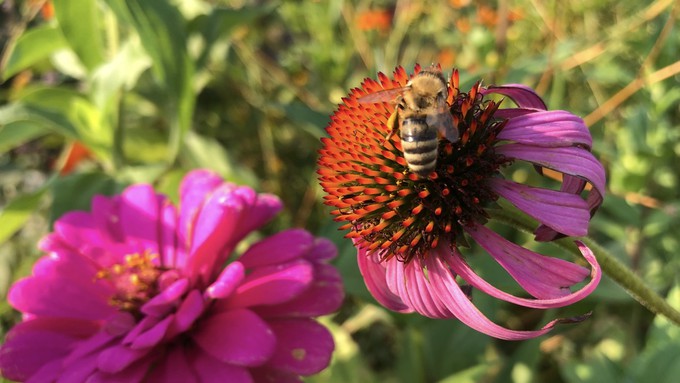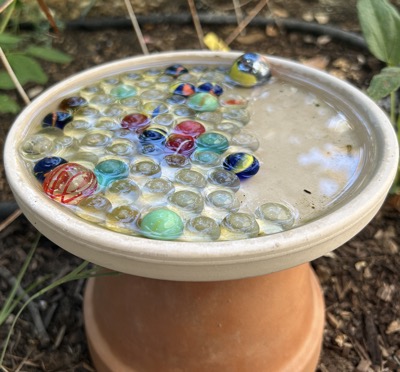
Water trays benefit these beneficial insects in more ways than one

A honey bee pauses for a bit of nectar as well as pollen from a coneflower. Honey bees search for water to cool the hive when temperatures get above 96.8 degrees. Kathy Morrison
People and pets aren’t the only ones who need ways to stay cool during triple-digit heat; bees could use some help, too.
Honey bees in particular benefit from water trays – shallow dishes of water with pebbles or marbles or corks – when temperatures go above 100 degrees. (The pebbles give bees a place to land so they don’t drown.) Honey bees are using that water not just to drink but to cool off their hives.
According to research from Oregon State University, honeybees use water – and wings – to create their own version of A.C.

“Honey bees are somewhat adapted to extreme heat,” report OSU researchers. “As soon as temperatures in a honey bee colony edge up beyond 96.8 degrees F., worker bees line up at the entrance and start fanning their wings. In addition, a special group of water-foraging bees begins scouring the surrounding area for water, which they collect and bring back to the nest.
“The bees distribute droplets of water around the nest, which works in parallel with the fanning to create the equivalent of honey bee A.C., or air conditioning. As temperatures rise to extreme heat levels, more honey bees will start to forage for water.”
Bumblebees tend to suffer most from the heat; they have trouble flying when it’s over 100 degrees, say the researchers. Bumblebees have been seen foraging for water (and may visit available water trays), but it’s not certain if they use the honey bee A.C. method to cool their nests.
Other bees don’t make as much use of the water trays, says OSU, but have other ways of coping. Ground-dwelling bees – which include many native bees – avoid the heat by staying under the cool soil.
One thing is certain: Most bee activity drops dramatically in triple-digit temperatures. Instead, they’ll forage (and pollinate) in the very early morning hours after dawn or just before twilight. Expect spotty pollination of squash and melons until weather cools back to normal.
How much longer will this current heat wave persist? According to the National Weather Service, Sacramento can expect afternoon highs over 100 through at least Thursday, July 11. That would match Sacramento’s all-time record of most consecutive triple-digit days – 11 – set in July 2009.
For more on bees and heat: https://extension.oregonstate.edu/gardening/pollinators/how-help-bees-survive-heat-wave.
For weather updates: https://www.weather.gov/sto/#.
Comments
0 comments have been posted.Sacramento Digs Gardening to your inbox.
Food in My Back Yard Series
May 6: Maintain soil moisture with mulch for garden success
April 29: What's (already) wrong with my tomato plants?
April 22: Should you stock up on fertilizer? (Yes!)
April 15: Grow culinary herbs in containers
April 8: When to plant summer vegetables
April 1: Don't be fooled by these garden myths
March 25: Fertilizer tips: How to 'feed' your vegetables for healthy growth
March 18: Time to give vegetable seedlings some more space
March 11: Ways to win the fight against weeds
March 4: Potatoes from the garden
Feb. 25: Plant a fruit tree now -- for later
Feb. 18: How to squeeze more food into less space
Feb. 11: When to plant? Consider staggering your transplants
Feb. 4: Starting in seed starting
Sites We Like
Garden Checklist for week of May 11
Make the most of the lower temperatures early in the week. We’ll be back in the 80s by Thursday.
* Plant, plant, plant! It’s prime planting season in the Sacramento area. Time to set out those tomato transplants along with peppers and eggplants. Pinch off any flowers on new transplants to make them concentrate on establishing roots instead of setting premature fruit.
* Direct-seed melons, cucumbers, summer squash, corn, radishes, pumpkins and annual herbs such as basil.
* Harvest cabbage, lettuce, peas and green onions.
* In the flower garden, direct-seed sunflowers, cosmos, salvia, zinnias, marigolds, celosia and asters. (You also can transplant seedlings for many of the same flowers.)
* Plant dahlia tubers.
* Transplant petunias, marigolds and perennial flowers such as astilbe, columbine, coneflowers, coreopsis, dahlias, rudbeckia and verbena.
* Keep an eye out for slugs, snails, earwigs and aphids that want to dine on tender new growth.
* Feed summer bloomers with a balanced fertilizer.
* For continued bloom, cut off spent flowers on roses as well as other flowering plants.
* Add mulch to the garden to maintain moisture. Mulch also cuts down on weeds. But don’t let it mound around the stems or trunks of trees or shrubs. Leave about a 6-inch-to-1-foot circle to avoid crown rot or other problems.
* Remember to weed! Pull those nasties before they set seed.
* Water early in the day and keep seedlings evenly moist.